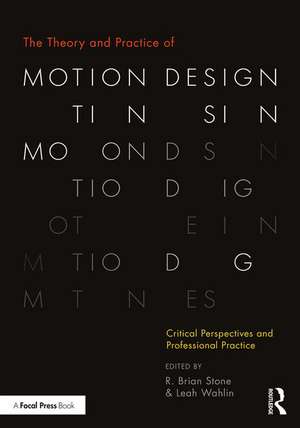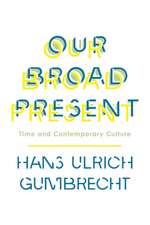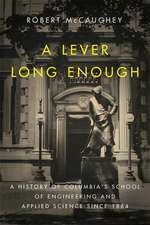The Theory and Practice of Motion Design: Critical Perspectives and Professional Practice
Editat de R. Brian Stone, Leah Wahlinen Limba Engleză Paperback – 23 iul 2018
Written for both those critically engaged with motion design as well as those working or aspiring to work professionally in the field, the book features a range of international contributors and interviews with some of the best-known designers in the field, including Kyle Cooper, Karin Fong, and Daniel Alenquer.
The Theory and Practice of Motion Design seeks to illuminate the diverse, interdisciplinary field of motion design by offering a structured examination of how motion design has evolved, what forces define our current understanding and implementation of motion design, and how we can plan for and imagine the future of motion design as it unfolds.
An accompanying online resource site, www.motionresource.com, contains visual representations of the examples described in the text.
Preț: 300.01 lei
Nou
Puncte Express: 450
Preț estimativ în valută:
57.42€ • 62.40$ • 48.27£
57.42€ • 62.40$ • 48.27£
Carte disponibilă
Livrare economică 31 martie-14 aprilie
Livrare express 14-20 martie pentru 45.99 lei
Preluare comenzi: 021 569.72.76
Specificații
ISBN-13: 9781138490802
ISBN-10: 1138490806
Pagini: 352
Dimensiuni: 178 x 254 x 20 mm
Greutate: 0.8 kg
Ediția:1
Editura: Taylor & Francis
Colecția Routledge
Locul publicării:Oxford, United Kingdom
ISBN-10: 1138490806
Pagini: 352
Dimensiuni: 178 x 254 x 20 mm
Greutate: 0.8 kg
Ediția:1
Editura: Taylor & Francis
Colecția Routledge
Locul publicării:Oxford, United Kingdom
Public țintă
Postgraduate, Professional, and UndergraduateCuprins
Introduction: A dialogue on the theory and practice of motion design - R. Brian Stone
Part 1: Theoretical Perspectives
Section 1: Interdisciplinary Influences and Origins
Liberating Words from the Printed Page - Dan Boyarski
The Evolution of the Motion Graphic Design Discipline Seen Through Its Definitions Over Time - Clarisa E. Carubin
Motion in Graphic Design: An Interdisciplinary Teaching Approach - Camila Afanador-Llach
Re-framing Design: Form, Meaning and Media - Jennifer Bernstein
Section 2: Communication Theory
Figures of Speech Applied to Motion Design - Bruno Ribeiro
On the Semiotics of Title Sequences: Three Modes of Text-Image Composition - Michael Betancourt
Towards the Cumulative Effect of Expository Motion Graphics: How Visual Explanations Resonate with Audiences - Spencer Barnes
Section 3: Science and Perception
Motion Attracts Attention - Elaine Froehlich
A conversation with Daniel Alenquer, Playerium
Part 2: Practice & Application
Section 1: Brand Building and Identities
A conversation with Guy Wolstenholme and Jon Hewitt, Moving Brands
Identities in Motion: Logo Introductions as Brand-Building Narratives - David Peacock
A conversation with Jakob Trollbäck, Trollbäck+Company
Section 2: Interface and Interaction Design
Navigating VOX/UI: The Integration of Motion in a Voice-Controlled
Information System - Andre Murnieks
A conversation with Jeff Arnold, Microsoft
Energetic Alpha: A Design Continuum Created Through Collaboration - Gretchen C. Rinnert, Aoife Mooney, and Marianne Martens
Section 3: Narrative and Storytelling
A conversation with Kyle Cooper, Prologue Films
The Blurry Intersection of Illustration and Motion Design - Adam Osgood
A conversation with Karin Fong, Imaginary Forces
Section 4: Space and Environment
Motion Design in the Context of Place - Cotter Christian and Catherine Normoyle
Motion Design and its Impact on Audiences – from Theory to Practice - Christina Lyons
Section 5: Experimental Visualizations & New Applications
Fragmented Motion: Split-Screen and Asynchronous Video - Steven Hoskins
A conversation with Isabel Meirelles, author of Design for Information
A conversation with Matt Pasternack, InfoMotion
Section 6: Educating Motion Designers
Notes on Education - R. Brian Stone
Teaching Motion Literacy through Music Visualization - Heather Shaw
Conversations on Educating Motion Designers
Kyle Cooper
Daniel Alenquer
Karin Fong
Guy Wolstenholme and Jon Hewitt
Isabel Meirelles
Jakob Trollbäck
Index
Part 1: Theoretical Perspectives
Section 1: Interdisciplinary Influences and Origins
Liberating Words from the Printed Page - Dan Boyarski
The Evolution of the Motion Graphic Design Discipline Seen Through Its Definitions Over Time - Clarisa E. Carubin
Motion in Graphic Design: An Interdisciplinary Teaching Approach - Camila Afanador-Llach
Re-framing Design: Form, Meaning and Media - Jennifer Bernstein
Section 2: Communication Theory
Figures of Speech Applied to Motion Design - Bruno Ribeiro
On the Semiotics of Title Sequences: Three Modes of Text-Image Composition - Michael Betancourt
Towards the Cumulative Effect of Expository Motion Graphics: How Visual Explanations Resonate with Audiences - Spencer Barnes
Section 3: Science and Perception
Motion Attracts Attention - Elaine Froehlich
A conversation with Daniel Alenquer, Playerium
Part 2: Practice & Application
Section 1: Brand Building and Identities
A conversation with Guy Wolstenholme and Jon Hewitt, Moving Brands
Identities in Motion: Logo Introductions as Brand-Building Narratives - David Peacock
A conversation with Jakob Trollbäck, Trollbäck+Company
Section 2: Interface and Interaction Design
Navigating VOX/UI: The Integration of Motion in a Voice-Controlled
Information System - Andre Murnieks
A conversation with Jeff Arnold, Microsoft
Energetic Alpha: A Design Continuum Created Through Collaboration - Gretchen C. Rinnert, Aoife Mooney, and Marianne Martens
Section 3: Narrative and Storytelling
A conversation with Kyle Cooper, Prologue Films
The Blurry Intersection of Illustration and Motion Design - Adam Osgood
A conversation with Karin Fong, Imaginary Forces
Section 4: Space and Environment
Motion Design in the Context of Place - Cotter Christian and Catherine Normoyle
Motion Design and its Impact on Audiences – from Theory to Practice - Christina Lyons
Section 5: Experimental Visualizations & New Applications
Fragmented Motion: Split-Screen and Asynchronous Video - Steven Hoskins
A conversation with Isabel Meirelles, author of Design for Information
A conversation with Matt Pasternack, InfoMotion
Section 6: Educating Motion Designers
Notes on Education - R. Brian Stone
Teaching Motion Literacy through Music Visualization - Heather Shaw
Conversations on Educating Motion Designers
Kyle Cooper
Daniel Alenquer
Karin Fong
Guy Wolstenholme and Jon Hewitt
Isabel Meirelles
Jakob Trollbäck
Index
Recenzii
"A riveting collection of essays, providing the unique point of view of some of the most inspired members of our industry. Whether you are interested in the science or the practical aspects of this field, this book is certain to provide rare insight, education and inspiration."
—Alberto Scirocco, President / Creative Director, leftchannel
"R. Brian Stone and Leah Wahlin have produced the best book on designing for motion since Peter von Arx’s classic Film Design. Their new book The Theory and Practice of Motion Design should be required reading for anyone concerned with how words and information move on screen and how movement contributes to meaning."
—Hugh Dubberly, Co-founder, Dubberly Design Office; Fellow AIGA SF; Member of the ACM SIGCHI Academy
"Instead of a ‘how-to’ book, this is a ‘how-to-think-about’ book that delivers on its title, combining the history and intellectual underpinnings of motion design with the insights of contemporary design professionals…a thoughtful response to the profession’s shift from the mute flat-land of print to today’s rich, multi-dimensional options for communications."
—Christopher Pullman, Senior Critic, Motion Design, Yale University School of Art; Former VP of Design and Visual Communications, WGBH, Public Broadcasting in Boston
—Alberto Scirocco, President / Creative Director, leftchannel
"R. Brian Stone and Leah Wahlin have produced the best book on designing for motion since Peter von Arx’s classic Film Design. Their new book The Theory and Practice of Motion Design should be required reading for anyone concerned with how words and information move on screen and how movement contributes to meaning."
—Hugh Dubberly, Co-founder, Dubberly Design Office; Fellow AIGA SF; Member of the ACM SIGCHI Academy
"Instead of a ‘how-to’ book, this is a ‘how-to-think-about’ book that delivers on its title, combining the history and intellectual underpinnings of motion design with the insights of contemporary design professionals…a thoughtful response to the profession’s shift from the mute flat-land of print to today’s rich, multi-dimensional options for communications."
—Christopher Pullman, Senior Critic, Motion Design, Yale University School of Art; Former VP of Design and Visual Communications, WGBH, Public Broadcasting in Boston
Descriere
This collection offers an expansive, multiplatform exploration of the rapidly-expanding area of motion design and motion graphics, taking into account both theoretical questions and creative professional practice. Spanning interaction design, product interfaces, kinetic data visualizations, typography, TV and film title design, brand building, narrative storytelling, history, exhibits and environments, editors R. Brian Stone and Leah Wahlin offer an interdisciplinary range of academic essays and professional interviews that together form a dialogue between motion design theory and professional practice.
Written for both those critically engaged with motion design as well as those working or aspiring to work professionally in the field, the book features a range of international contributors and interviews with some of the best-known designers in the field, including Kyle Cooper, Karin Fong, and Daniel Alenquer.
The Theory and Practice of Motion Design seeks to illuminate the diverse, interdisciplinary field of motion design by offering a structured examination of how motion design has evolved, what forces define our current understanding and implementation of motion design, and how we can plan for and imagine the future of motion design as it unfolds.
Written for both those critically engaged with motion design as well as those working or aspiring to work professionally in the field, the book features a range of international contributors and interviews with some of the best-known designers in the field, including Kyle Cooper, Karin Fong, and Daniel Alenquer.
The Theory and Practice of Motion Design seeks to illuminate the diverse, interdisciplinary field of motion design by offering a structured examination of how motion design has evolved, what forces define our current understanding and implementation of motion design, and how we can plan for and imagine the future of motion design as it unfolds.










